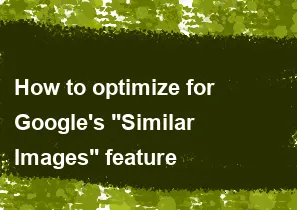How to optimize for Google's "Similar Images" feature

Google's "Similar Images" feature is not a specific service provided by Google, and I don't have information on any particular optimization strategies for such a feature. However, if you're referring to optimizing images for search engines in general, including Google Images, here are some best practices:
Image Relevance:
- Use images that are relevant to the content on the page.
- Make sure the images accurately represent the topic or subject matter.
File Name:
- Use descriptive file names for your images. Avoid generic names like "image001.jpg."
- Include relevant keywords in the file name.
Alt Text:
- Provide descriptive and concise alt text for each image.
- Alt text helps search engines understand the content of the image.
Image Size:
- Optimize image size to ensure faster loading times. Use compressed and appropriately sized images.
- Google tends to favor pages with faster loading times.
Image Format:
- Use widely supported image formats like JPEG, PNG, or WebP.
- Consider using the appropriate format based on the image content (e.g., JPEG for photographs, PNG for transparent images).
Image Sitemap:
- Create an image sitemap and submit it to Google Search Console.
- This helps search engines discover and index your images more efficiently.
Surrounding Content:
- Ensure that the surrounding text content on the page is relevant to the images.
- Contextual information can help search engines understand the relationship between the content and the images.
Schema Markup:
- Implement structured data/schema markup, including image-related schema, to provide additional context to search engines.
Mobile Optimization:
- Optimize images for mobile devices to enhance the user experience.
- Google considers mobile-friendliness as a ranking factor.
Backlinks:
- Acquire high-quality backlinks to your pages, as they can indirectly influence image search rankings.
Remember that search engine algorithms can change, and it's essential to stay updated on the latest SEO practices. Regularly check for any new guidelines or features introduced by Google that may impact image optimization. Additionally, consider checking Google's official documentation for the most current information.
-
Popular Post
- How to optimize for Google's About This Result feature for local businesses
- How to implement multi-language support in an Express.js application
- How to handle and optimize for changes in mobile search behavior
- How to handle CORS in a Node.js application
- How to use Vue.js with a UI framework (e.g., Vuetify, Element UI)
- How to configure Laravel Telescope for monitoring and profiling API requests
- How to create a command-line tool using the Commander.js library in Node.js
- How to implement code splitting in a React.js application
- How to use the AWS SDK for Node.js to interact with various AWS services
- How to use the Node.js Stream API for efficient data processing
- How to implement a cookie parser middleware in Node.js
- How to implement WebSockets for real-time communication in React
-
Latest Post
- How to implement a dynamic form with dynamic field styling based on user input in Next.js
- How to create a custom hook for handling user interactions with the browser's device motion in Next.js
- How to create a custom hook for handling user interactions with the browser's battery status in Next.js
- How to implement a dynamic form with dynamic field visibility based on user input in Next.js
- How to implement a dynamic form with real-time collaboration features in Next.js
- How to create a custom hook for handling user interactions with the browser's media devices in Next.js
- How to use the useSWRInfinite hook for paginating data with a custom loading indicator in Next.js
- How to create a custom hook for handling user interactions with the browser's network status in Next.js
- How to create a custom hook for handling user interactions with the browser's location in Next.js
- How to implement a dynamic form with multi-language support in Next.js
- How to create a custom hook for handling user interactions with the browser's ambient light sensor in Next.js
- How to use the useHover hook for creating interactive image zoom effects in Next.js